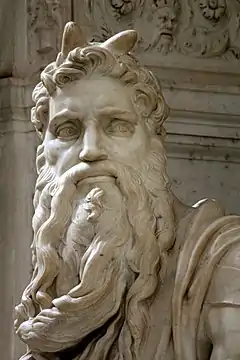Terribilità
Terribilità, the spelling in modern Italian, or terribiltà, as Michelangelo's 16th century contemporaries tended to spell it, is a quality of provoking terror (the literal meaning), awe, or a sense of the sublime, in the viewer, that is ascribed to his art. It is perhaps especially applied to his sculptures, such as his figures of David or in Moses.

Pope Julius II was apparently the first to describe Michelangelo as a uomo terribile ("terror-inducing man"), apparently describing his difficult character as much as his art. This terribilità, also references the neoplatonics of humanists such as Marsilio Ficino, who had known Michelangelo in his youth.[1]
Michelangelo's friend and collaborator Sebastiano del Piombo reported in a letter to him of 15 October 1520 on a private audience with Pope Leo X. After praising Michelangelo's work, the pope continued "But he is terribile, as you see; one cannot deal with him". Sebastiano responded "that your terribile character did not harm anyone, and that you appear terribile for love of the great works you carry out."[2]
References
- Lleó Cañal, Vicente, Revista de Libros:Tintoretto 2, 2 Abril 2007, p.2
- Exhibition handlist for "Michelangelo & Sebastiano", 2017, National Gallery. Catalogue # 33, from Casa Buonarroti, Florence.
Bibliography
- Hodson, Rupert (2000). Miguel Ángel, escultor. Brand. ISBN 978-84-95481-02-3.
- Martín González, Juan José (1974). Juan de Juni: vida y obra. Dirección General de Bellas Artes, Ministerio de Educacíon y Ciencia, [Patronato Nacional de Museos. ISBN 978-84-369-0335-5.